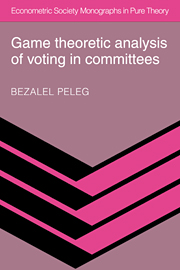Book contents
- Frontmatter
- Background and Motivation
- 1 Introduction and Summary of the Main Results
- 2 Preliminary Concepts and Basic Results
- 3 Representations of Committees
- 4 Strong and Dynamic Representations
- 5 Exactly and Strongly Consistent Anonymous Social Choice Functions
- 6 Effectivity Functions and Implementation
- 7 Concluding Remarks
- References
- Author Index
- Subject index
3 - Representations of Committees
Published online by Cambridge University Press: 05 January 2013
- Frontmatter
- Background and Motivation
- 1 Introduction and Summary of the Main Results
- 2 Preliminary Concepts and Basic Results
- 3 Representations of Committees
- 4 Strong and Dynamic Representations
- 5 Exactly and Strongly Consistent Anonymous Social Choice Functions
- 6 Effectivity Functions and Implementation
- 7 Concluding Remarks
- References
- Author Index
- Subject index
Summary
This chapter is devoted to a detailed investigation of the relationship between committees (formally, simple games) and social choice correspondences and functions. We begin our investigation in Section 3.1 by associating three simple games, which are derived from three different notions of effectiveness, with every social choice correspondence. These games serve to describe the power distribution induced by a social choice correspondence among the various coalitions of voters. We proceed with a study of the properties of, and the interrelations between, the three simple games. Then we consider several examples, including the Borda rule. A social choice correspondence is tight if our three notions of effectiveness coincide for it. We conclude Section 3.1 by demonstrating that certain conditions are sufficient for tightness. In Section 3.2 we consider the converse problem, namely, that of finding representations (i.e., choice procedures or, more formally, social choice correspondences) for committees. We find sufficient conditions for tightness of representations, and we prove, by constructing suitable examples, the existence of tight and “nice” representations. We also find that the solution to the representation problem is closely related to the investigation of cores of simple games.
- Type
- Chapter
- Information
- Game Theoretic Analysis of Voting in Committees , pp. 38 - 62Publisher: Cambridge University PressPrint publication year: 1984
- 1
- Cited by



